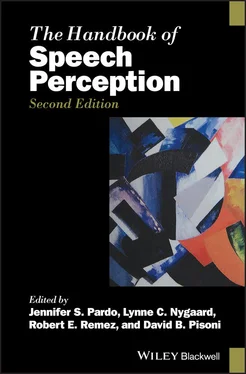Taken together, these findings provide further evidence that (1) features are used in mapping from sounds to words; (2) importantly, even nonwords access the lexicon, with activation of a lexical entry a function of the number of overlapping features shared; and (3) the activation of a lexical entry is graded, the extent of the activation being a function of the goodness of fit between the auditory input and its lexical phonological (feature) representation; and (4) the degree to which a lexical representation is activated has a cascading effect on the degree of activation of its lexical semantic network.
Features: Binary or graded
In linguistic theory, features are binary; that is, they are either present (+) or absent (−). For example, the stop consonant [d] would be marked as [−nasal] to contrast it from the nasal consonant [n] which is marked [+nasal].The preceding section on “Feature dimensions” in speech perception and lexical access is consistent with this view. However, it has long been known that membership in phonetic categories is not all‐or‐none. Rather, there is a range of values associated with parameters or features of speech with some values appearing to be more representative than others. On the face of it, it would suggest then that, in speech perception, features may be graded. What is critical is whether such graded representations influence not only speech‐perception processes but also lexical access processes. We now turn to this question.
As we shall see, experimental evidence challenges the view that features are binary and rather supports the view that features are graded. This has consequences not only for speech‐perception processes but also for the mapping from phonetic category representations to lexical representations and for ultimately accessing the lexical semantic network.
Asking participants to categorize a continuum of speech stimuli varying in equal acoustic steps from one phonetic category to another results in a categorical‐like function, for example, [d] to [t] varying in 10 millisecond (ms) voice‐onset time steps. There is a range of stimuli consistently categorized as [d] and a range of stimuli consistently categorized as [t], with one or two stimuli at the edges of or on the boundary between the two categories less consistently categorized. Nonetheless, it turns out that not all members within a phonetic category are perceived equally.
Using more sensitive measures than phonetic categorization including reaction time (Pisoni & Tash, 1974) and judgments of category goodness (Miller, 1997; Iverson & Kuhl, 1996), speech‐perception studies have shown that listener reaction times are slower in identifying a stimulus on a continuum, and their judgments of category goodness are reduced as stimuli approach the phonetic category boundary. Variations in task requirements support the robustness of these gradient effects (e.g. Carney, Widin, & Viemeister, 1977). Thus, phonetic categories are graded and have an internal structure to them (see Miller, 1997). In this sense, categories are not truly binary representations that are either present or absent, but rather some exemplars of a category are better representations of the category than others.
Such findings support a functional architecture in which the degree of activation of a representation is itself graded and influences, as well, the degree of activation of potential competitors. As a stimulus approaches the phonetic category boundary, its activation decreases and there is a concomitant increase in the activation, and hence the extent of competition with the contrasting phonetic category representation. For example, assume a [da]–[ta] continuum ranging in 10 ms steps from 0–40 ms voice onset time (VOT) with a category boundary of 20 ms. As described earlier, there is competition between stimuli that share acoustic properties. Thus, presentation of a 40 ms stimulus (perceived as a [d]) would compete with the representation of the contrasting voiced phonetic category [t]. However, a stimulus with a VOT of 30 ms is a poorer exemplar of the voiceless phonetic category, and thus not only does it activate the phonetic representation of [t] more weakly, but there is an increase in the activation of the contrasting voiced phonetic category [d] (see Blumstein, Myers, & Rissman, 2005).
Neural evidence also supports the gradient nature of phonetic categories. Both temporal and frontal areas show graded responses as a function of the goodness of the phonetic category input, with the least activation for the best exemplar of the phonetic category and increased activation as stimuli on a continuum approach the phonetic category boundary (Blumstein, Myers, & Rissman, 2005; Frye et al., 2007; Guenther et al., 2004). Importantly, other neural areas (middle frontal gyrus, supramarginal gyrus) fail to show such graded activation, displaying sensitivity only to between‐phonetic‐category and not to within‐phonetic‐category differences (Joanisse, Zevin, & McCandliss, 2007; Myers et al., 2009). That there is both graded and categorical perception of phonetic categories reflects two critical aspects of speech perception: the need for sensitivity to fine acoustic differences on the one hand, and sensitivity to category membership on the other. We will return to this point in the Conclusion of this chapter.
Results showing that the perception of phonetic categories is graded and is influenced by the goodness of the stimulus input raises the question of potential effects on lexical access. One possibility is that phonetic category membership is resolved at the phonetic‐phonological level and the fine acoustic differences leading to graded responses at this level are not mapped onto higher levels of processing. Alternatively, given the functional architecture of the speech and lexical processing system proposed earlier, graded phonetic category representations should influence the mapping from the phonetic‐phonological levels to lexical representations. Results of a series of experiments using various methodologies support this latter hypothesis.
Using the visual world paradigm, it has been shown that access to lexical representations is affected by the fine acoustic structure of the auditory input. In particular, it has been shown that looks to a visual target are affected by within‐phonetic‐category acoustic differences (McMurray, Tanenhaus, & Aslin, 2002; see also McMurray, Tanenhaus, & Aslin, 2009). In the 2002 study of McMurray and colleagues, eye movements were measured as participants identified a named target word (using a mouse click) from an array of four pictures. The pictures consisted of a target word whose name began with a labial stop consonant, for example pear , a minimal pair of the target bear , and two phonologically unrelated words, for example lamp and ship . The auditorily presented names varied along a [b]–[p] VOT continuum ranging from 0–40 ms in 5 ms steps. Results showed graded responses with increasing looks to the competitor minimal pair (i.e. bear ) as the acoustic‐phonetic input (a VOT variant of [p]) approached the phonetic boundary. These findings show that lexical access is indeed graded.
Perhaps stronger evidence of the effects of within‐phonetic‐category differences on access to higher levels of processing comes from studies showing that within‐phonetic‐category effects not only influence access to lexical representations but also cascade to the lexical semantic network. Examining semantic priming in a lexical decision task, Andruski Blumstein, and Burton (1994) presented prime words semantically related to a target stimulus in which the initial voiceless stop consonant of the prime was an exemplar stimulus (spoken naturally and acoustically unmodified) or it was a poorer exemplar of the voiceless stop phonetic category (the VOT was reduced by one third or two thirds). Shortening the VOT of the stimuli rendered them closer to the voiced phonetic category boundary. Importantly, pilot work showed that stimuli presented alone were perceived correctly as beginning with voiceless stop consonants. However, the reduction of the VOT for the acoustically modified stimuli resulted in a reduction in the magnitude of semantic priming relative to the unmodified prime stimuli, particularly for the primes reduced by two thirds.
Читать дальше








![О Генри - Справочник Гименея [The Handbook of Hymen]](/books/407356/o-genri-spravochnik-gimeneya-the-handbook-of-hymen-thumb.webp)



